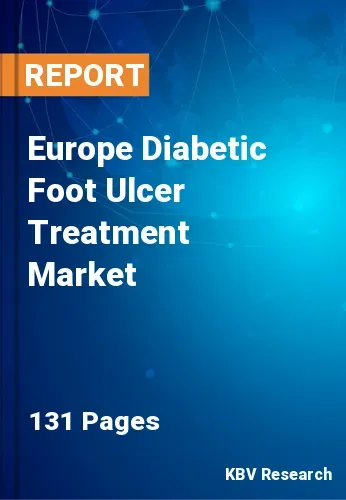The Europe Diabetic Foot Ulcer Treatment Market would witness market growth of 5.0% CAGR during the forecast period (2023-2030).
Bioactive substances, including growth factors, extracellular matrices, and tissue-engineered goods, have shown promising outcomes in aiding tissue regeneration and wound healing. Additionally, these compounds may promote angiogenesis, drive cellular growth, and result in the development of new tissue. As a result, they are often utilized as complementary treatments to quicken the healing of diabetic foot ulcers.
The market has grown as a result of the interdisciplinary strategy that has been used to address diabetic foot ulcers. Collaboration between various healthcare specialists is required for this method, including podiatrists, vascular surgeons, wound care experts, endocrinologists, and infectious disease specialists. Additionally, government programs and assistance significantly impact the market. Around the region, governments and healthcare organizations are implementing initiatives to advance foot care education, create specialist diabetic foot clinics, expand patient access to healthcare services, and improve payment practices for treating diabetic foot ulcers. These programs seek to lessen the prevalence of foot ulcers and their related problems.
Because of increased rates of overweight and obesity, a poor diet, and inadequate exercise, diabetes is becoming more common among individuals of all ages in Europe. Diabetes affects 60 million individuals in the European Union, or 10.3% of men and 9.6% of women who are 25 years of age or older. Furthermore, the International Diabetes Federation (IDF) reports that 15.3% of Germans have diabetes. The organization estimates a 25% increase above the rate from the previous year (12.2%). It is estimated that 9.5 million individuals in Germany have diabetes, which puts them at risk for potentially lethal complications.
Out of the 9.5 million people, the 4.5 million without a diagnosis are at a greater risk. The need to implement Germany's national diabetes strategy, stipulated in the coalition agreement 2018, is made clear by these dismal statistics. 3.9 million people in the United Kingdom have diabetes. Five million more individuals in the UK will be affected by 2025. The need for preventive care is brought on by the growing incidence of diabetes, which is also linked to an increased risk of diabetic neuropathy, diabetic ulcers, and other complications. Consequently, the market for treating diabetes-related foot ulcers would expand.
The Germany market dominated the Europe Diabetic Foot Ulcer Treatment Market by Country in 2022, and would continue to be a dominant market till 2030; thereby, achieving a market value of $427.1 million by 2030. The UK market is exhibiting a CAGR of 4.1% during (2023 - 2030). Additionally, The France market would experience a CAGR of 5.8% during (2023 - 2030).
Based on Product, the market is segmented into Wound Care Dressings, Wound Care Devices (Negative Pressure Wound Therapy, and Others), Biologics, and Others. Based on Type, the market is segmented into Neuroischemic Ulcers, Neuropathic Ulcers, and Ischemic Ulcers. Based on End User, the market is segmented into Homecare Settings, Hospitals, and Others. Based on countries, the market is segmented into Germany, UK, France, Russia, Spain, Italy, and Rest of Europe.
Free Valuable Insights: The Worldwide Diabetic Foot Ulcer Treatment Market is Projected to reach USD 6.5 Billion by 2030, at a CAGR of 5.2%
The market research report covers the analysis of key stake holders of the market. Key companies profiled in the report include Coloplast Group, B. Braun Melsungen AG, Integra LifeSciences Holdings Corporation, Smith & Nephew PLC, Cardinal Health, Inc., Medtronic PLC, 3M Company, Molnlycke Health Care AB, Essity AB and ConvaTec Group PLC.
By Product
By Type
By End User
By Country

Our team of dedicated experts can provide you with attractive expansion opportunities for your business.

